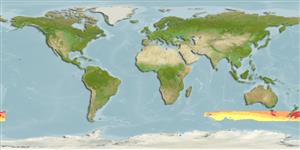Common names from other countries
分類 / Names
俗名 | 同種異名 | Catalog of Fishes(屬, 種) | ITIS | CoL | WoRMS | Cloffa
Teleostei >
Zeiformes (Dories)
海魴目 (Dories) >
Oreosomatidae (Oreos)
高的鯛科 (Oreos) > Oreosomatinae
Etymology: Allocyttus: Greek, allos = other + Greek, kyttaros, kytos = a convex cavity; niger: niger refers to the blackish color of freshly caught specimens. It also reflects the common name "black oreo", which has been widely used in the New Zealand deepwater fishery for several years (Ref. 27159).
Environment: milieu / climate zone / depth range / distribution range
生態學
海洋 深海區的; 海洋洄游的 (Ref. 51243); 深度上下限 560 - 1300 m (Ref. 6390). 深水域; 43°S - 55°S, 65°E - 174°W (Ref. 27159)
Southwest Pacific: New Zealand and Australian waters south of 43°S, and south of Tasmania at 47°S. Also Ref. 26139.
西南太平洋: 紐西蘭與 43個 °S 澳洲水域南方.(參考文獻 27159) 也參考文獻 26139.
Length at first maturity / 大小 / 重量 / 年齡
Maturity: Lm ?, range 36 - ? cm
Max length : 47.0 cm TL 雄魚/尚未辨別雌雄; (Ref. 6390); common length : 35.0 cm TL 雄魚/尚未辨別雌雄; (Ref. 9258); 最大體重: 1.5 kg (Ref. 6390); 最大年齡: 100 年 (Ref. 27140)
Found close to the sea bed in deep water. Form large shoals over rough ground near pinnacles and canyons. Juveniles are pelagic and inhabit oceanic waters. They tend to be dispersed over smooth grounds (Ref. 6390). Feed mainly on salps and benthic crustaceans (Ref. 27150). Eggs float near the sea surface and larvae also inhabit surface waters (Ref. 6390). Based on trawl catch rates, there is no evidence of vertical migration during day or night (Ref. 27150).
發現在深水中接近海床。 形成大群魚群在峰頂與峽谷附近的粗糙的底部之上。 稚魚是大洋性的而且居住於大洋性水域。 他們傾向零零散散的在平滑的地面之上.(參考文獻 6390) 主要捕食被囊動物與底棲的甲殼動物。 (參考文獻 27150) 在海洋表面與仔魚附近的卵漂流物也居住於水表面。 (參考文獻 6390) 以拖網捕捉率為依據, 沒有對於垂直性迴游的證據在白天或夜晚.(參考文獻 27150)
Life cycle and mating behavior
成熟度 | 繁殖 | 產卵場 | 卵 | 孕卵數 | 仔魚
Displays seasonally synchronised reproduction.西南太平洋: 紐西蘭與 43個 °S 澳洲水域南方.(參考文獻 27159) 也參考文獻 26139.
James, G.D., T. Inada and I. Nakamura, 1988. Revision of the oreosomatid fishes (Family Oreosomatidae) from the southern oceans, with a description of a new species. N.Z. J. Zool. 15:291-326. (Ref. 27159)
CITES (Ref. 128078)
Not Evaluated
人類使用
漁業: 商業性
更多資訊
參考文獻養殖養殖資訊品種遺傳學Electrophoreses遺傳率疾病加工Mass conversion
合作者照片Stamps, Coins Misc.聲音神經毒速度泳型鰓區Otoliths腦重體重比眼睛色素
工具
特別的報告
下載 XML
網路資源
Estimates based on models
Preferred temperature (Ref.
115969): 2.1 - 6.8, mean 5.1 (based on 63 cells).
Phylogenetic diversity index (Ref.
82804): PD
50 = 0.5635 [Uniqueness, from 0.5 = low to 2.0 = high].
Bayesian length-weight: a=0.01413 (0.00715 - 0.02792), b=3.03 (2.85 - 3.21), in cm Total Length, based on LWR estimates for this species & (Sub)family-body (Ref.
93245).
營養階層 (Ref.
69278): 3.5 ±0.50 se; based on food items.
回復力 (Ref.
120179): 非常低的, 最小族群倍增時間超過14 年 (tmax=100; tm=27; Fec >5,000).
Fishing Vulnerability (Ref.
59153): High to very high vulnerability (69 of 100).
Climate Vulnerability (Ref.
125649): Moderate vulnerability (40 of 100).
